#sufi initiate
Text

(Prophet Muhammad by Nicholas Roerich)
“In general, it is to the measure of one’s alienation from one’s own ego that one attains direct knowledge of one’s Lord… I heard Abu Ali al-Daqqaq say, ‘One of the tokens of the gnosis of God is the achievement of deep awe and reverence for God. If someone’s realization increases, his awe increases.’ And I heard him say, ‘Gnosis requires stillness of heart, just as learning requires outward quiet. If someone’s gnosis increases, his tranquility increases.’” ―Al-Qushayri, Al-Risalah: Principles of Sufism
The highest spiritual realizations cited throughout the world’s major religions are accessible to advanced practitioners well established within the most profound esoteric disciplines. Those who were prepared to work with the most expedient method for spiritual awakening were delivered the key from mouth to ear: the science of sexual knowledge, known in Arabic as marifah, alchemy or Allah-kimia: “to fuse with God,” otherwise referred to as gnosis in Greek and Da’ath in Kabbalah.
Building off the prior stages of ethical conduct and conscious love taught in this course, this lecture elaborates on the secret path and methods for knowing the most elevated, divine realities, especially as demonstrated by the exemplary life of Prophet Muhammad. Learn also the Arabic Kabbalah and Tree of Life, the three stages of religious practice and knowledge, the Sufi writings on witnessing the divine, the science of certainty within the Holy Qur’an, and the esoteric significance of Al-Miraj: the Ascension or Night Journey of the Prophet.
#sufism#sufi initiate#sufi literature#sufi wisdom#sufi master#islamic mysticism#islamic#islam#quran#alchemy#kabbalah#gnostic kabbalah#spirituality#gnosticism#awakening#meditation#consciousness#chicago gnosis#samael aun weor#gnostic academy of chicago#chicago gnosis podcast#spiritual awakening#meditation podcasts#apple podcasts#spiritual podcasts#religion#gnosis#gnostic#mysticism#divine wisdom
9 notes
·
View notes
Text
The first step towards the crystallisation of what we today call Hinduism was born in the consciousness of being the amorphous, subordinate, other. In a sense this was a reversal of roles. Earlier the term mleccha had been used by the upper caste Hindus to refer to the impure, amorphous rest. For the upper castes, Muslims and especially those not indigenous to India, were treated as mleccha since they did not observe the dharma and were debarred from entering the sanctum of the temple and the home. Indigenous converts to Islam also came under this category but their caste origins would have set them apart initially from the amorphous Muslim. Now the upper and lower castes were clubbed together under the label of ‘Hindu’, a new experience for the upper castes.
This in part accounts for the belief among many upper caste Hindus today that Hinduism in the last one thousand years has been through the most severe persecution that any religion in the world has ever undergone. The need to exaggerate the persecution at the hands of the Muslim is required to justify the inculcation of anti-Muslim sentiments among the Hindus of today. Such statements brush aside the fact that there were various expressions of religious persecution in India prior to the coming of the Muslims and particularly between the Śaiva and the Buddhist and Jaina sects and that at one level, the persistence of untouchability was also a form of religious intolerance. The authors of such statements conveniently forget that the last thousand years in the history of Hinduism have witnessed the establishment of the powerful Śankarācārya maṭhas, āśramas, and similar institutions attempting to provide an ecclesiastical structure to strengthen Brahmanism and conservatism; the powerful Daśanāmi and Bairāgi religious orders of Śaiva and Vaiṣṇava origin, vying for patronage and frequently in confrontation; the popular cults of the Nāthapanthis; the significant sects of the Bhakti traditions which are to be found in every corner of the subcontinent; and more recently a number of socio-religious reform movements which have been aimed at reforming and strengthening Hinduism. It was also the period which saw the expansion of the cults of Kṛṣṇa and Rāma with their own mythologies, literatures, rituals and circuits of pilgrimage. What defines many Hindus today has roots in the period of Muslim rule. Facets of belief and ritual regarded as essential to Hinduism belong to more recent times. The establishment of the sects which accompanied these developments often derived from wealthy patronage including that of both Hindu and Muslim rulers, which accounted for the prosperity of temples and institutions associated with these sects. The more innovative sects were in part the result of extensive dialogues between gurus, sādhus, pīrs and Sufis, a dialogue which was sometimes confrontational and sometimes conciliatory. The last thousand years have seen the most assertive thrust of many Hindu sects. If by persecution is meant the conversion of Hindus to Islam and Christianity, then it should be kept in mind that the majority of conversions were from the lower castes and this is more a reflection on Hindu society than on persecution. Upper caste conversions were more frequently activated by factors such as political alliances and marriage circuits and here the conversion was hardly due to persecution. Tragically for those that converted on the assumption that there would be social equality in the new religion, this was never the case and the lower castes remained low in social ranking and carried their caste identities into the new religions.
When the destroying of temples and the breaking of images by Muslim iconoclasts is mentioned—and quite correctly so—it should however at the same time be stated that there were also many Muslim rulers, not excluding Aurangzeb, who gave substantial donations to Hindu sects and to individual brāhmaṇas. There was obviously more than just religious bigotry or religious tolerance involved in these actions. The relationship for example between the Mughal rulers and the Bundela rājās, which involved temple destruction among other things, and veered from close alliances to fierce hostility, was the product not merely of religious loyalties or differences, but the play of power and political negotiation. Nor should it be forgotten that the temple as a source of wealth was exploited even by Hindu rulers such as Harṣadeva of Kashmir who looted temples when he faced a fiscal crisis, or the Paramāra ruler who destroyed temples in the Caulukya kingdom, or the Rāṣṭrakūṭa king who tore up the temple courtyard of the Pratihāra ruler after a victorious campaign. Given the opulence of large temples, the wealth stored in them required protection, but the temple was also a statement of political authority when built by a ruler.
The European adoption of the term ‘Hindu’ gave it further currency as also the attempts of Catholic and Protestant Christian missionaries to convert the Gentoo/Hindu to Christianity. The pressure to convert, initially disassociated with European commercial activity, changed with the coming of British colonial power when, by the early nineteenth century, missionary activities were either surreptitiously or overtly, according to context, encouraged by the colonial authority. The impact both of missionary activity and Christian colonial power resulted in considerable soul searching on the part of those Indians who were close to this new historical experience. One result was the emergence of a number of groups such as the Brahmo Samaj, the Prathana Samaj, the Arya Samaj, the Ramakrishna Mission, the Theosophical Society, the Divine Life Society, the Swaminarayan movement, et al., which gave greater currency to the term Hinduism. There was much more dialogue of upper caste Hindus with Christians than there had been with Muslims, partly because for the coloniser power also lay in controlling knowledge about the colonised and partly because there were far fewer Hindus converting to Christianity than had converted to Islam. Some of the neo-Hindu sects as they have come to be called, were influenced by Christianity and some reacted against it; but even the latter were not immune from its imprint. This was inevitable given that it was the religion of the coloniser.
The challenge from Christian missionaries was not merely at the level of conversions and religious debates. The more subtle form was through educational institutions necessary to the emerging Indian middle class. Many who were attracted to these neo-Hindu groups had at some point of their lives experienced Christian education and were thereafter familiar with Christian ideas. The Christian missionary model played an important part, as for example in the institutions of the Arya Samaj. The Shaiva Siddhanta Samaj was inspired by Arumuga Navalar, who was roused to reinterpret Śaivism after translating the Bible into Tamil. The movement attracted middle-class Tamils seeking a cultural self-assertion. Added to this was the contribution of some Orientalist scholars who interpreted the religious texts to further their notions of how Hinduism should be constructed. The impact of Orientalism in creating the image of Indian, and particularly Hindu culture, as projected in the nineteenth century, was considerable.
Those among these groups influenced by Christianity, attempted to defend, redefine and create Hinduism on the model of Christianity. They sought for the equivalent of a monotheistic God, a Book, a Prophet or a Founder and congregational worship with an institutional organization supporting it. The implicit intention was again of defining ‘the Hindu’ as a reaction to being ‘the other’; the subconscious model was the Semitic religion. The monotheistic God was sought in the abstract notion of Brahman, the Absolute of the Upaniṣads with which the individual Ātman seeks unity in the process of mokṣa; or else with the interpretation of the term deva which was translated as God, suggesting a monotheistic God. The worship of a single deity among many others is not strictly speaking monotheism, although attempts have been made by modern commentators to argue this. Unlike many of the earlier sects which were associated with a particular deity, some of these groups claimed to transcend deity and reach out to the Absolute, Infinite, the Brahman. This was an attempt to transcend segmentary interests in an effort to attain a universalistic identity, but in social customs and ritual, caste identities and distinctions between high and low continued to be maintained.
— Romila Thapar, Syndicated Hinduism.
#reference#reading list#romila thapar#history#aijaz ahmad keeps using the phrase “syndicated hinduism”#and i needed an etymology
24 notes
·
View notes
Text

The Embrace (Lovers II)
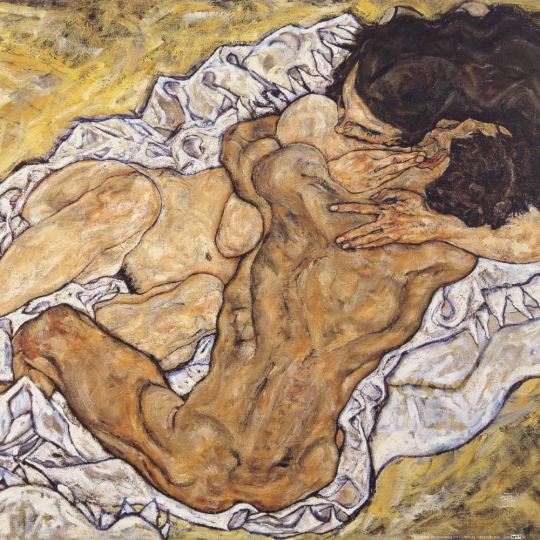
The Embrace (Lovers II) 1917. Egon Schiele
14 notes
·
View notes
Text
The Five Names of God: Simran Words - Spiritual Awakening Radio Podcast - A Satsang Without Walls

In many branches of Sant Mat we have a five-name (panch naam) mantra (five simran words). These are sacred names of God associated with the first five planes, heavenly realms of creation. From the glossary of Sant Mat we read: "Simran means Remembrance: repetition of names or thoughts; in Sant Mat, the simran of worldly thoughts is controlled through the Simran of the Five Charged Names, repeated by an initiate throughout the day, and when sitting for meditation, as a means of collecting the thought-currents at the Third Eye Center. These Divine names are also used as passwords of sorts to higher planes, and provide protection from Negative Power influences." (Repeat the Name)
Today: all about the Five Names of Sant Mat, their proper use as an essential technique to concentrate at the Third Eye Center and go within according to Hazur Baba Sawan Singh, Sant Garib Das, from the Satsang Discourses of Sant Ram Singh, as well as there is discussion about the origins and history of the Five Names dating back to the Kabir-Sant Dharam Das line of Masters. Also explored: the Five Sufi Names, and about the importance of the Most High name Radhasoami used by Sant Garib Das (Anmol Vachan) and Swami Ji Maharaj (Sar Bachan Radhaswami Poetry). In Sant Mat mysticism there are not five or seven deities but one God, the one Lord of the Soul manifesting at the various levels of creation. As Guru Nanak has said in his Morning Prayer (Jap Ji): "There is One God, Truth is His Name." (One Love)
The Five Names of God: Simran Words - Spiritual Awakening Radio Podcast @ YouTube:
https://youtu.be/JAfca83Jox4
YouTube Channel: Spiritual Awakening Radio Podcasts:
https://www.youtube.com/@SpiritualAwakeningRadio/videos
The Five Names of God: Simran Words - Spiritual Awakening Radio Podcast - Listen or Download MP3 @
https://traffic.libsyn.com/spiritualawakeningradio/The_Five_Names_of_God.mp3
@ the Podcast Website With Buttons That Go To the Popular Podcast APPS - Wherever You Follow Podcasts:
https://SpiritualAwakeningRadio.libsyn.com/the-five-names-of-god-simran-words
@ Apple Podcasts:
https://podcasts.apple.com/us/podcast/the-five-names-of-god-simran-words/id1477577384?i=1000643766511
Collection of Spiritual Awakening Radio Podcasts @ Apple:
https://podcasts.apple.com/us/podcast/spiritual-awakening-radio/id1477577384
@ Spotify Podcasts:
https://open.spotify.com/episode/2UWbqjkGQBrOMWteT0x3dT
@ Amazon Music and Podcasts:
https://music.amazon.com/podcasts/ca7918b0-4005-4724-a2e5-b27f51ecdba6/spiritual-awakening-radio
& @ Wherever You Subscribe and Follow Podcasts - At Your Favorite Podcast APP Just Do a Search for "Spiritual Awakening Radio" - (Youtube, Youtube Music, Apple Podcasts, Spotify, Google Podcasts, Amazon, Audible, PodBean, Podcast APP, Overcast, Jio Saavan, iHeart Radio, CastBox, etc...):
https://linktr.ee/SpiritualAwakeningRadio
Simran is described as a Bhakti practice to be done in a spirit of love and devotion, with passages on this from Sant Tulsi Sahib and Kabir. (God is Love)
Mention is made of a mystical Jewish Gnostic sect of antiquity referred to by scholars as the Sethians who also had a five-name mantra approach, only using five Hebrew names, which are to be found embedded in certain Nag Hammadi and other texts. Recommended are two books that compare contemporary Sant Mat with mystical Judaism including Kabbalah. The program concludes with selections from the mystical poetry of a mysterious figure called "the Master" and "the Teacher of Righteousness", mystic verses found in the Psalm Scroll of the Dead Sea Scrolls mainly about the experience of Divine Light, but one might also notice references to reincarnation, the liberation of the soul, the Third Eye, and spiritually hearing the Divine Word or Spiritual Sound. Note: practices associated with contemporary Sant Mat were also known in earlier times by followers of various cousin mystical movements and schools of spirituality that have existed over the centuries. Even ideas that became associated Christianity and Gnostic movements such as seeking out living masters or living ones (Odes of Solomon, Gospel of Thomas), vegetarian ethics, humane treatment of animals (scriptures attributed to Enoch and Isaiah), initiations, baptism in rivers of living water, a new covenant (Dead Sea Scroll texts), genesis interpretations that include a lesser demiurge figure and a sophia wisdom figure (Septuagint, Apocryphon of John), the view that the soul needs to ascend through a series of heavenly regions (Book of First Enoch, Songs of the Sabbath Sacrifice, Ascension of Isaiah, Ginza Rabba) are ideas developed during the Second Temple period of Judaism. Continuations and interpretations of Judaic ideas were adopted by many sects and spiritual movements during the first and later centuries AD. (Education For a More Peaceful Planet!)
At the Feet of the Masters,
James Bean
Spiritual Awakening Radio Podcasts
Sant Mat Satsang Podcasts
Sant Mat Radhasoami
A Satsang Without Walls
https://www.SpiritualAwakeningRadio.com
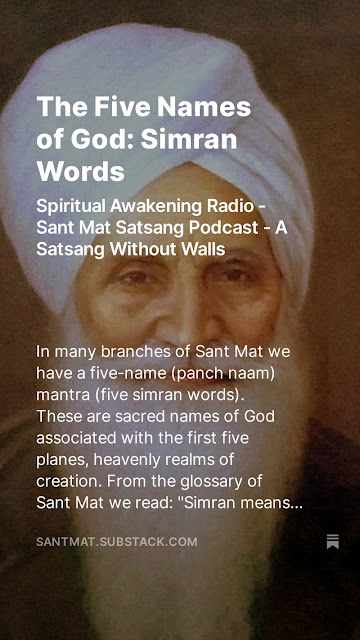
#Spirituality #Meditation #Simran #Satsang #God #SantMat #Radhasoami #SuratShabdYoga #Gnosticism #Kabbalah #DeadSeaScrolls #Podcasts #SpiritualAwakeningRadio #SpiritualityPodcasts #SpiritualPodcasts #Sant_Mat #Radha_Soami #Radhaswami #Radhasoamiji #ScienceOfTheSoul #ScienceOfSpirituality #RSSB #RSSBBeas #RssbQuote #ThirdEye #ThirdEyeOpen #ThirdEyeThoughts #ThirdEyeAwakening #ThirdEyeChakra #3rdEye
#simran#names of God#prayer of the name#sacred names#mantras#jappa#meditation#spirituality#spiritual awakening radio#podcast#mysticism#gnosticism#kabbalah#dead sea scrolls#sant mat#radhasoami#satsang
13 notes
·
View notes
Text
ISLAM 101: Spirituality in Islam: Part 163
Samt (Silence)
Literally meaning avoiding speech and keeping silent, samt is used by the Sufis to describe keeping silent or preferring silence in self-possession to avoid the useless or harmful utterances that one can make while speaking. Aware of the Divine warning, Not a word does he utter but there is a watcher by him, ever-present (50:18), the term samt also means that one should speak when necessary and only for the good pleasure of God, uttering words that are pleasing to God. The saying of the glorious nightingale of creation, the Prophet Muhammad, upon him be peace and blessings, “Either speak of good or keep silent,”[1] is a most concise, decisive definition of samt, and provides the frame of reference that one should remain within when speaking and keeping silent. We should also remind ourselves of another saying attributed to him: “Let your speech be wisdom, and your silence reflection.”[2]
Speaking too much, in particular speaking empty words, is something that has always been condemned and regarded as one of the sinful acts which lead people to perdition. Those who have been initiated into spiritual journeying to God have continuously been warned against speaking too much and against useless words as this is a sinful act of the tongue. It has been emphasized that eating too much, sleeping too much, and speaking too much are each a collar around the necks of the travelers to God, chains on their feet, and handcuffs around their wrists—for they lead one to make frequent mistakes and commit frequent sins. The saying attributed to Caliph ‘Umar, may God be pleased with him, “Whoever speaks much errs much,”[3]corroborates this point.
Both the books of good morals and the epistles of Sufism have studied and explained the idea of keeping silent, each from their own perspective, attaching great importance to this virtue by regarding it as important wealth for an initiate, a secret treasure for those who have reached the final point of journeying, and a sign of good manners for every believer.
This does not mean that a believer should keep silent in every case. A believer should speak to advise and promote good or prevent evil, to teach and guide, to remove what is harmful, and to encourage and introduce what is useful. Our religion orders us to utter what should be said to support and establish truth and justice so that everyone can receive their rightful due, and forbids us from keeping silent in such cases. It can be said that however harmful and condemnable it is for one to speak without seeking God’s approval or good pleasure and thereby pursuing a lawful purpose, it is equally harmful and condemnable for one to keep silent when and where one should speak. For this reason, although keeping silent is generally approved and advisable, speaking is sometimes more approved than silence. Silence, in other words, while it is not always golden, is sometimes silver. It is of great importance to know where and when one should keep silent, and where and when one should speak. In a Prophetic Tradition, the person who keeps silent where right and justice are violated and truth is desecrated is regarded as a “mute devil”; those who speak false and useless words are considered to be the friends and translators of Satan.
It is both an ethical behavior and indicative of their knowing their place in the “market of thought and speech” that those who should speak are given the opportunity to speak, while others whose speech is not useful should remain silent. In this respect, it has been said:
If your merchandise is copper, O brother,
Do not offer it for sale in the market.
Leave the market to those who sell jewelry.
Keeping silent in the presence of people with profound spiritual states and wisdom shows that one has good manners and that one respects such profound spiritual states and wisdom. Concerning this, the Shaykhu’l-Islam Yahya Efendi[4] says:
Give ear to the speech of the people of profound spiritual states.
Do not compare their speech to other speeches.
You know, O preacher, that every speech is different from others.
Silence accompanied by self-supervision in the presence of those who have reached the final point of journeying and who have been favored with God’s company is also emphasized. This silence of the people of heart, who can recognize people of true merit and worth, means respect for both the hearts where Divine inspirations descend and for the One Who has favored these hearts with satisfaction. They remain silent where they should and prepare the ground for the breezes of inspirations to blow, setting their tables not for the worldly bounties, but for the ever-fresh fruits of Paradise.
It sometimes occurs that the matter to be discussed is so profound that it transcends our horizon of perception to the extent that we should keep silent and invite others around us to silence. Sayings such as, “No need to present our need, for the state we are in is expressive of everything,” and the silent prayer, “Consider what a wretched state we are in, and do not leave us alone!” are the voices of such silence. Jalalu’d-Din ar-Rumi makes the following invitation to it:
Look at my pale face, but do not say anything to me!
See my countless pains, but for God’s love, do not say anything to me!
Look at my heart in profuse blood, and my tears flowing like a stream!
But ignore whatever you see, and do not ask how and why!
Common people hold their tongues and only keep silent physically, while those who have certain knowledge of God keep control of both their tongue and heart, and so experience self-supervision in silence. As for the lovers of God, they keep their love and yearning within themselves and so represent the silence of faithfulness. The first of these three groups are saved from blunders of speech and protect themselves from censure and reproach. Those of the second group receive, in addition to what silence itself may bring, the spiritual gifts which come through reflection and self-supervision. As for those of the third group, it is stated in the following couplet:
You say that you are a lover, then do not sigh with the ordeal of love!
Do not make others aware of your ordeal by sighing!
Thus, they are able to keep their secrets in silence and display an example of deep faithfulness.
O God, include us among Your servants, sincere in faith and in the practice of Islam, and those whom You have particularly favored with sincerity; bestow Your blessings and peace upon our master, Muhammad, the leader of those whom You have favored with sincerity, and on his Family and Companions, who both love You and are loved by You.
[1]al-Bukhari, “Adab” 31; Muslim, “Iman” 74.
[2] al-Ghazzali, Ihya’ ‘Ulum ad-Din, 1:3; 2:228.
[3] at-Tabarani, al-Mu’jam al-Awsat, 2:370; al-Bayhaqi, Shu’ab al-Iman, 4:257.
[4] Shaykhu’l-Islam Yahya Efendi (1553–1644) was one of the most famous Shaykhu’l-Islams of the Ottoman State. The office of Shaykhu’l-Islam was the highest Office of religious affairs. Yahya Efendi was also a well-known poet.
#allah#god#islam#muslim#quran#revert#convert#convert islam#revert islam#reverthelp#revert help#revert help team#help#islamhelp#converthelp#how to convert to islam#convert to islam#welcome to islam
12 notes
·
View notes
Text
🌈☪️ List of LGBTQI+ friendly Mosques and Muslim Congregations:
This is a list of mosques,muslim/islamic congregations that welcomes queer,trans,non-binary,intersex,BIPOC Muslims. The list is curated by Bangladeshi Bisexual Muslim @nakibistan. In this list some of the mosques/islamic congregations are radically “inclusive” to all folks. Please note that, some of the mosques & muslim congregations in this list only welcome to queer folks.
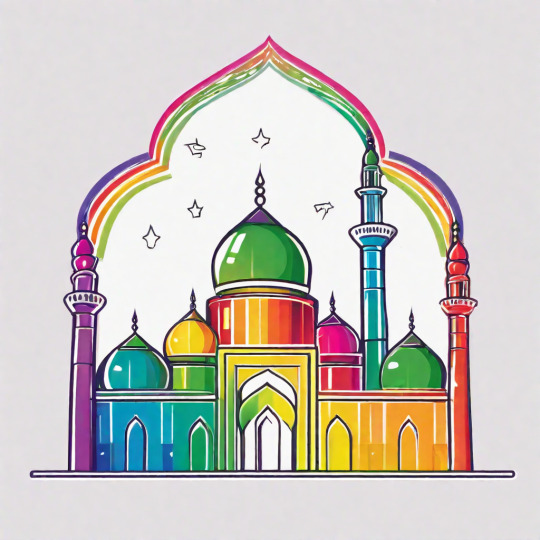
USA 🇺🇸
MPV-NY Unity Mosque, New York – Started by MPV-NY Chapter
MPV-LA Unity Mosque – Started by MPV-LA chapter
Unity Mosque of San Francisco – Started by MPV-SF Chapter
Atlanta Unity Mosque – Started by el-Tawhid Juma Circle & MPV
Unity Mosque, Chicago – Started by MPV Chicago
Unity Mosque, Boston – Started by MPV-Boston Chapter.
Unity Mosque, Columbus – Started by MPV-Columbus
Masjid an-Nur al-Issalah – Started by MPV-DC.
Masjid al-Rabia, South Loop downtown of Chicago – An intersectional, women-led, queer-affirming mosque.
Qalbu Maryam Mosque – A woman led, queer-friendly mosque
Masjid al-Inshirah – Started by Pioneer Valley Progressive Muslims group. The mosque also welcomes LGBTQI+ muslims
Masjed Fatimah – A shia-centric, inclusive mosque
Rainbow Crescent Mosque – A virtual queer-friendly mosque
Masjid Daar ul-Gharib – A virtual intersectional, queer-friendly mosque.
Masjid-ul-Hub – An online mosque for LGBTQI+ Muslims
Masjid al-Musawa – An online mosque for queer muslims
Haven, Philadelphia – An inclusive muslim congregation also includes LGBTQ+ muslims
Jummah 4 All collective
Mercy Community Center
Dergah al-Farah, Manhattan Downtown of NY – Radical inclusive sufi lodge of Nur Ashki Jerrahi order
The Circle of Ishq of Minneapolis – An inclusive Sufi lodge Jerrahi community
The Atlanta Circle – An inclusive sufi lodge of Nur Ashki Jerrahi
Nur Ashki Jerrahi Michigan Dervish
Nur Ashki Jerrahi Pittsburg Drevish
La Order Sufi Yerraji/Nur Ashki al-Jerrahi Sufi Order of New Mexico - Progressive, liberal Mexican sufi dervish of US
Muslim Space, TX – A texas-based BIPOC, queer-friendly, gender-inclusive community
Redwood Unity Mosque Initiative (RUMI),CA – A small congregation of progressive muslims in Redwood. It was affiliated with eTJC (don't know it's still active or not)
New England Unity Mosque (NEUM) – A Unity mosque of New England. This mosque was affiliated with el-Tawhid Juma Circle.
UK 🇬🇧
Inclusive Mosque Initiative (IMI) – An inclusive congregation that opened first LGBTQI+ friendly, women-led mosque in Britain
Nur Ashki Jerrahi Order of UK – Sufi lodge of Leeds/London
Imaan LGBTQ+ Muslim Charity
France 🇫🇷
Mosquée Inclusive de l’unicité , Goutte d'Or neighborhood of Paris – France's first unity mosque started by Imam Ludovic Ahmad Zahed
Frederico Joko Procopio's Buddhist Dojo, Paris – egalitarian congregation where french queer muslims prayed
Progressive Islamic Center, Marseille
Fatima Mosque – A progressive, women-led, mixed-gender mosque
Musulmans Inclusifs de France – A progressive muslim congregations of France
Voice of an Enlightened Islam (VOIX) – A progressive, spiritual & radically inclusive congregation for all. VOIX also runs Simorgh Mosque, which welcomes LGBTQ+ muslims
Canada 🇨🇦
Masjid el-Tawhid/Toronto Unity Mosque - It is the first unity mosque of el-Tawhid Juma Circle (eTJC) & Canada
Ottawa Valley Unity Mosque (OVUM)
Vancouver Unity Mosque, British Columbia
Halifax Unity Mosque, Nova Scotia (don't know it's still active or not. please contact eTJC for details)
Kitchener Waterloo Unity Mosque
Calgary Alberta Unity Mosque
Madison Unity Mosque
Queer Muslim Network
Germany 🇩🇪
Ibn Rushd Goethe Moschee,Berlin – A liberal, feminist mosque for sunni, shia, sufi, ahmadi, non-religious, BIPOC, queer, man & woman folks
Liberal-Islamischer Bund e.V. – A largest feminist, liberal muslim congregation of German
Australia 🇦🇺
Australia's first Unity Mosque
MPV-Australia
Norway 🇳🇴
Masjid Al-Nisa – A women-led, LGBTQ+ friendly mosque in Oslo
Italy 🇮🇹
Moschea al-Kawthar/Al-kawthar Mosque – A virtual intersectional mosque started by Sveva Basirah Balzini
Mexico 🇲🇽
Tasním Nur Ashki Al Yerrahi, Cuernavaca – Radically inclusive sufi dervish for all genders & sexualities
South Africa 🇿🇦
Masjid ul-Umam ( People's Mosque), Cape town – First egalitarian mosque of Africa
Masjid ul-Ghurbaah – An inclusive mosque for marginalised muslims, runs by al-Ghurbaah Foundation
The Open Mosque – An egalitarian, mixed gender mosque for all
Claremont Main Road Mosque, Cape town – A mixed-gender mosque in South Africa. The mosque also welcome HIV+ & LGBTQI+ folks
Pakistan 🇵🇰
Khusrain Wale Shahi Masjid/ Khusray wale masjid, Jalalpur of Punjab – Punjab's oldest mosque of transgender eunuchs (also known as Khusra/Khusray)
Rehmatul Alameen Masjid,Islamabad
Dargah of Hazrat Lal Shahbaz Qalandar
Shrine of Shah Hussain/Madhoo Lal Hussain – An important site for queer & trans muslims where they can explore the divinity of love & find solace
India 🇮🇳
Hijron Ka Khanqah, Delhi – A historical sufi khanqah with a small mosque. The mosque is only for muslim Hijras (an umbrella term for transgender,eunuch, transvestite,gender non-binary & intersex folks)
Khawaja Gharib Nawaz Dargah
Ajmer Sharif Dargah
Nizamuddin Dargah
Masjid Syed Gauhar Ali Shah Qadeem, Delhi (this mosque doesn't allow women to pray besides men)
Masjid-e-Mukhannisan/Hijron Wali Shahi Masjid, Lohamandi of Agra – A historical mosque was built by Emperor Akbar to honour his favourite Mukhannas Itibar Khan
Indonesia 🇮🇩
Pondok Pesantren Waria Al-Fatah, Yogyakarta – Indonesia's first Islamic centre for Warias (Indonesian local term for trans woman)
Bangladesh 🇧🇩
Dakshin Char Kalibari Masjid, Mymensingh – Bangladesh's first hijra mosque
Turkey 🇹🇷
Alevi Muslims are providing safe spaces for LGBTQI+ to pray
Ağalar Mosque in Topkapı Palace – A historical mosque for gender non-confirming eunuchs
30 notes
·
View notes
Text
Scattered throughout occult and shamanic literature are references to the imagination, or “seeing with the mind’s eye,” and similar metaphors. In the sixteenth century, Paracelsus said, “Everyone may educate and regulate his imagination so as to come thereby into contact with spirits, and be taught by them.”
[...]
Similarly, a Nganasan Samoyed shaman of Siberia reported that during his initiatory dismemberment, a spirit also changed his eyes, so that he could see, not with bodily eyes, but with “mystical eyes.” Others remark on the intensity of the shaman’s gaze, and the brightness of the eyes is frequently mentioned. A. P. Elkin commented that an Aboriginal Australian medicine man he encountered had “shrewd penetrating eyes—eyes that look you all the way through—the lenses of a mind that is photographing your very character and intentions,” and the Berndts wrote that the medicine man was noticeably different from others because of the light radiating from his eyes.
[...]
Imagination and intuition are closely tied to shamanic and magical abilities, and both can be enhanced by persistent cultivation and training, paying attention to one’s inner feelings and reactions. Employing all the senses in using the imagination is recommended: if one visualizes a forest, for example, one needs to see the forest, hear and feel the wind in the branches, smell the vegetation, listen for the sounds of the forest, its animals, insects, and birds, and feel the energies in the forest, a totally multisensorial experience. In Sufism, the batin is a realm of idea images, subtle substances, scenes on which visionary events and symbolic histories appear and are considered “true reality.” Using creative imagination through the active imagination is what the Sufis call “science of the heart,” and allows the Sufi entrance into the alam al-mithal (the intermediate world). The active imagination, known as theophanic imagination, together with strong emotion, will, desire, and focused attention or concentration allow Sufi mystics to see things that normally cannot be seen.
These same factors are employed by Western occult magicians. By focusing on mental images, the occultist can use the imagination and focused concentration to bring an image into visible appearance. It may not be visible to others, but the magician is able to see it. Magicians train themselves to create an image, hold it, and improve the vividness and controllability of the image to sustain it. When proficiency at mental imaging is perfected, the practitioner can perceive things directly on the “astral levels.” Occultist Israel Regardie insists on the importance of visualization and mental imagery cultivation before a practitioner of magic can move on to the next stages of training. Shamans also often undergo visualization training, with the goal of developing the “inner eye,” or “strong eye,” sometimes also referred to as the “third eye” in magico-religious traditions. The imagination is an important foundational stage to visualization training, which includes image enhancement and increasing the vividness of an image.
[...]
One opens up the senses to allow the familiar to be seen in different ways. The Otherworld, writes MacLellan, is entered initially through the power of the imagination; once versed in the imagination, it can be experienced as “a blend of the dreams and experiences of other beings and of the land itself,” where one can meet “talking foxes and watch the shapes of stone people unfold from the rocks on a hillside.” Dreams, nightmares, or magic can access the Otherworld. People in the Otherworld “respond using the images we carry in our heads to give themselves forms that we can relate to.” “Spirits,” he says, “touch us with premonition, a fleeting unease, an atmosphere or a passing dream”.
-- Hume & Drury (ed.), The Varieties of Magical Experience
57 notes
·
View notes
Text
SIDRATU'L MUNTAHA (The Lote-Tree of the Furthest Limit)
Sidr literally means Arabian cherry; it also means astonishment or something that is spectacular. Sidratu’l-Muntaha denotes the limit, the final point, the furthest boundary of the realm of contingencies. Some have interpreted it as the final point which death-bound beings can reach. Based on certain Prophetic sayings and reports from either the Prophet, upon him be peace and blessings, or from some of his Companions, the illustrious interpreters of the Qur’an depict Sidratu’l-Muntaha as a blessed tree which exists to the right of God’s Supreme Throne and below which flow the rivers of Paradise, which have been promised to the God-revering, pious. In order to emphasize the extent of the area it covers, our master, upon him be the most perfect of blessings and peace, says: “If a horseman were to gallop for seventy years across its shadow, he would not be able to traverse it; a single leaf of it can cover an entire nation.” If we use greater units of measurement to express the extent of the area it covers, we would not be exaggerating. For the Sidra marks the farthest boundary of the realm of creation; here it meets with the realm of the initial manifestations of Divine Commands. The realm of contingencies ends here. The branches, shoots, and leaves of the huge tree of creation, which extends in all directions, end here. Also, the views of saintly people who deepen in spirituality and those with progressive hearts who can penetrate the inner dimension of things can extend only this far. The perfected ones, who are always careful of where they put their feet and how they take each step on the way to God, stop at this boundary, without being able to take a single step further. Everyone breathes with amazement here. For what lies beyond is included in the realm of the absolute Unseen, which none other than God can know.
Another meaning of the Sidratu’l-Muntaha is that it signifies such a horizon of astonishment and amazement, and such a peak of passion and stupor that “there is neither space in it nor heavens and earth; and no mind can grasp this state” . Of the many heroes of spirituality that have emerged from humanity from the beginning of existence, none other than the Honor and Pride of Humankind, and the Peerless of Time and Space, upon him be the most perfect blessings and peace, has ever been able to rise as far as that horizon or reach that peak. Those who have reached it in their spirit have been dazzled and bewildered, being stuck in amazement and stupor. It was only the Pride of Humankind whose sight did not swerve, nor did it go wrong; indeed, he saw one among the greatest signs of His Lord (53:17–18). The point where he reached was Sidratu’l-Muntaha, which, marks the sacred horizon between the absolutely Necessary Existence and contingency. The first and last traveler who reached this peak is the Seal of Prophethood, for whose sake the worlds were created. No one preceding him and no one succeeding him has a share in this status. How beautiful is the following couplet:
No one who came before him attained this highest status;
No one has ever been favored with this height.
It is not possible for us to be able to imagine either the depths of Prophet Muhammad’s spirituality or the things he saw and heard or his experiences. We preserve our perceptions and experiences and try to understand them according to the interpretations of purified, saintly scholars.
According to some Sufis, Sidratu’l-Muntaha is the horizon where God Almighty favors the outer and inner worlds of His noble, distinguished servants and their spirits, souls, minds, imaginations, and original natures with the manifestations of, respectively, his Names the All-Outward and the All-Inward, and of His proper Name, His Attribute of Lordship, and His Names the All-Merciful and the Ultimate Truth. It is also the peak where God manifests His Attributes of Glory. No matter how profound and extensive emotions may be, all human information, knowledge, sensations and perceptions end at the Sidratu’l-Muntaha and cannot go beyond. Any claims to have gone beyond this horizon only relate to particular spiritual experiences in certain exceptional states of spiritual intoxication, and have therefore no objective value.
#islam#muslim#allah#god#convert#revert#quran#ayat#religion#reminder#help#hijab#muslimah#dua#salah#pray#prayer#prophet#muhammad#sunnah#hadith#welcome to islam#how to convert to islam#new revert#new convert#new muslim#revert help#convert help#islam help#muslim help
10 notes
·
View notes
Text
Jumu'ah Sohbet: 5 January 2024
Alhamdulillah (Divine praise) that we have made it into the first week of January in the new year of our turbulent worldly existence. It is where humanity perennially wars;
i. Unwittingly, as individuals with our respective nafs (ego / lower-self),
ii. as nations or intra-nationally as in Sudan and,
iii. an alarmingly close reality is with planet Earth itself.
In that context was our Saturday Sohbet (spiritual conversation), which was deeply explored by Shaykh Mir of Tanzania. It was on the types of knowledge that we ought to acquire and its relationship to our fundamental Zikr in "La ilaha illallah" / There is nothing but the Divine. BIsmillah (With-and-not-For Allah, as substantiated by Shaykh Mir. When we act, we must do it with Allah! It is an important semantic making our relationship with Allah as Sufi Muslims even more intimate.
#1. Shaykh Mir first relayed how most of us came from conventional, organised religions, which are initially helpful, but we reach a point where we want more. What distinguishes a person in a Tariqa is that we are seekers.
It was congruent with my experience, which began with blind submission to secular values, to the total opposite of diligent Qur'anic Arabic studies and formal halaqa, and shockingly after this, did I plummet! Until I was saved by our Shaykh Nishaat, who opened the door to Sufism and both your Abbu and him that exemplified its teachings. Shaykh Mir described accurately my experience where we seek some answers that are ultimately deep within us. We later learn that the questions can not be resolved in an easy way unless we have spiritual mentors who take us under their fold to guide us.
It then becomes about the acquisition of knowledge as our Tariqa is committed to, with its dedication to fostering lifelong learning. Our Prophet SAW said, "Acquire knowledge from the cradle to the grave and acquire knowledge as far as China." But what is the knowledge that we are seeking? There is a verse of the Qur'an which says, "Verily the possessors of knowledge are in awe of Allah!" What we are seeking is the knowledge of the Divine, though this may not be possible with only our outer senses because of the limitation of the mind! I realised the shortfalls of the dogged focus on the exoteric / external spiritual path, which is only truly completed with the esoteric / internal path offered through Sufism!
#2. Thereafter, he rightly highlighted the importance of moving beyond ritualistic worship. Making a habit of something makes it an imitation, and the inner seeking is forgotten because of the challenges of the nafs. The nafs that we have has forgotten its true nature, which was blown into it by Allah. Instead, we develop an "I-ness" where everything is relatively taken where I am the doer, I am the seeker, and that identity of "I-ness" has covered the essence of Allah.
We become the doer of the attributes that we exhibit. That is the challenge that we have in our practice and daily life. What we should infact be seeking is perceiving Allah through all our outer and inner senses. In Tariqa, we are taught about the attributes of Allah, but we have to go to the essence of that attribute!
#3. Most importantly, he emphasised the importance of remembering La ilaha illallah within us? We have to experience the external, but if we have the La ilaha illallah / There is only the Divine engrossed into us, it will affect every component of us where we develop the sense that we are not the doer! We acquire a sense of peace within ourselves, where we see that the level of integration of La ilaha illallah within ourselves is directly proportional to what we are experiencing in the outside world!
However, our attachments and desires to the outside world are so much that it doesn't give time and room for La ilaha illallah to come up. Whereas on the path of Tassawuf, which is the science of purifying the heart, is what Tariqa focuses on. The La ilaha illallah integration within our life is the only key; knowing, feeling, and spreading it with our family and friends is the only thing that exists!
#4. Shaykh Anjum echoed Shaykh Mir in that the spiritual path is not easy! He added a colourful analogy of our self-realisation only being achieved if we are like pliable, kneaded dough that is ultimately baked at high temperatures 😅
For people who have been in the oven, they know the process and the result. This is the understanding that we ought to keep within a Tariqa, with a spiritual mentor. If we understand this, we will be a wonderful piece of golden brown bread that smells good, too 🍞 After I meekly dawdled to Shaykh Taner, appologising for taking long to connect with him, he graciously replied that it didn't matter and what mattered more is that I was there. I, subsequently, continue to weep happy tears of gratitude!
Shaykh Anjum poetically added that when we are saying La ilaha illallah, constantly and consistently - it leaves a mark on us where we are moved out of the way as the doers! We then have to increase the number of repetitions until it goes from Zahir (manifest / apparent) to Batin (inner/ hidden) and becomes autopilot where Allah takes over! We must be present, consistent, and have the urge to commit to lifelong learning.
#5. Shaykh Mir then powerfully reflected on the Fanafil Shaykh issue. Many misconstrue it as shirk (idolatry), whereas in his experience, he could feel Shaykh Taner doing a specific action. He added,
When I am connected, I am not necessarily doing it intentionally or that I am always engaging Shaykha, though. When I, as Mir, am not there, I can feel Baba (spiritual father Shaykh Taner). I can't necessarily visualise the Prophet SAW or him, but I can see his hands and feet, and the tradition is with him.
It comes to good use when we are selfless. So our focus is Fanafil Shaykh, followed by Fanafil Rasullulah SAW, and then Fanafillah. It's the tradition where a lineage of people is guiding us because the road is not easy. It is tough, and the more that we want to be close to the knowledge, the more we are put into the grind, and it burns us. We can resist it, but then we will not attain the peace and bliss that we are actually seeking.
In conclusion, as a Tariqa, we inherently wade in an ocean of being and a system of lifelong learning geared towards self-realisation. We are a diverse and deep lot, through outer and especially inner worship of Allah:
Shukran Ya Allah (Divine gratitude)
4 notes
·
View notes
Text
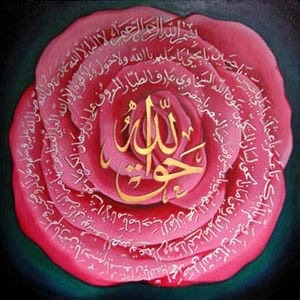
Spiritual Perception
“Imagination, Inspiration, and Intuition are the three obligatory paths for the initiation. We reach these ineffable heights by means of concentration, meditation and samadhi. Whosoever has reached these ineffable heights of intuition has converted himself into a master of samadhi." ―Samael Aun Weor, Igneous Rose
Despite their elusive character, mystical experiences possess three distinct, eternal principles: Imagination (perception of non-physical imagery), Inspiration (joyful recognition of divine symbolism), and Intuition (comprehension of their hidden meaning). Through cultivating an ethical lifestyle, meditators can awaken to their true nature and access profound spiritual knowledge. Discover how through the teachings of the Sufis, the Buddha, and Samael Aun Weor.
#spirituality#gnosticism#gnosis#awakening#meditation#consciousness#gnostic#spiritual#chicago gnosis#gnostic academy of chicago#chicago gnosis podcast#spiritual awakening#mysticism#religion#how to meditate#samael aun weor#sufism#sufi literature#sufi master#sufi wisdom#sufi quotes#sufi mystic#islamic mysticism#islam#kabbalah#esoteric#spiritual exercises#spiritual path#spiritual podcast#meditation podcasts
37 notes
·
View notes
Text
183. Tracy and Laura Hickman - I3: Pharaoh (1982)
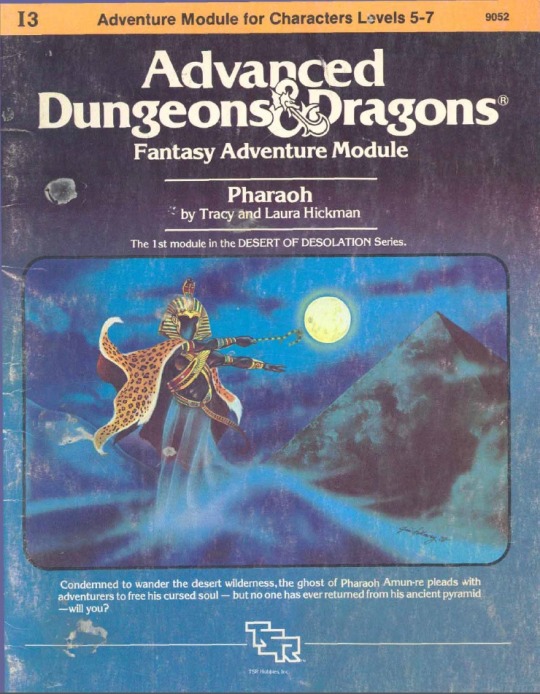
The third in the Intermediate "I" series of modules and the first of the Desert of Desolation series, which would further include I4 and I5, this is basically the AD&D take on Ancient Egyptian/Middle Eastern setting. Later it would be retconned to be set in Faerûn, but here we don't get a specific setting.

There are good and bad things about this setting, let me get the bad ones out of the way first. The Dervish that show up here are a kind of "dirty Arab" stereotype to oppose the players and feel a bit beyond the pale today. In the real world Dervish is a name for Sufi Order Initiates in Islam, it's a religious term for a member of a living religion and a mystical practice in that religion, they aren't "fantasy monsters" or ninjas, which is what they look like here. Let's chalk it up to this being 1982 and standards for cultural sensitivity being different, and move on. It's easy for a DM to make them something else if running this module today and I think that would be a good option. Another problem is the fact that the story doesn't make much sense, but then that's also typical of modules of the time, particularly ones like this which is really a reprint of a adventure that the Hickmans had released under their own company in the 70s.

The good things are just the cool desert setting and some innovations in the story telling. It's easy to see that the Hickmans really cared about fleshing out their world, and there is an amount of lore here which is uncommon for stories of this period. Room descriptions have lore sections with explanations of the history of the place or translations of writings on the walls, there are even a couple of books that you can attempt to read and have transcribed at the end of the module. This gives a real sense of place and history to the module, which means that even with a somewhat weak plot there is still plenty of crunchy lore to get your teeth into here.

#adnd#dnd#ttrpg#ad&d#d&d#dnd art#dungeons and dragons#dungeons & dragons#tracy hickman#laura hickman
6 notes
·
View notes
Text
Bajirao Mastani: The Plight of the Cheating Husband
Follow me on Instagram: @thatguyanesejournalist
Let’s talk about Sanjay Leela Bhansali’s Bajirao Mastani.

Bajirao is a Hindu Peshwa (minister to the king of the Maratha empire) who falls in love with Mastani, a Muslim warrior princess, while married to his wife Kashibai. The movie centers around Bajirao and Mastani’s interfaith relationship and the opposition against it from Bajirao’s conservative Hindu family.

I would like to start off this post by saying I support polygamy/polyamory, just not in the way it’s presented here. Let’s call it like it is: Bajirao and Mastani’s relationship would be cute as hell if he wasn’t cheating on his wife. I’d like to give Mastani the benefit of the doubt and say she initially didn’t know Bajirao was married, but I don’t think that would’ve stopped her since she still accepted his condition that Kashi will always remain his first wife.
One thing I admire the film for doing is creating sympathy for Kashibai, especially in her and Bajirao’s last scene together in her bedchambers (one of my favorite scenes in the film). She didn’t ask for much, but ended up expecting very little from her husband in the loyalty department.

I’ll be honest, though, I adored Mastani’s character. She was strong and independent, even fighting side-by-side with Bajirao in the war. She wanted a man, but didn’t necessarily need one. While I don’t agree with her going all the way to Pune for him, Mastani clearly showed that she’s determined to get what she wants and will find multiple methods to achieve it.

Plot aside, I absolutely loved the movie. Not only were there two strong female characters that I felt were well-developed as the movie went on, but the dialogue is on a different level of poetic and impactful at the same time. It makes you cry (or was it just me?) when mixed with the grand visuals and subtle but emotionally moving acting performances. Here are some of my favorite lines/moments:
“I cherish your every offering, be it an anklet or a son.” - Mastani
“Perhaps you forget that idols in temples are often adorned in green and saffron sheets cover the purest Sufi tombs. Where is the thought of color and religion then?” - Mastani
The scene where Mastani fights people in Mastani Mahal, holding her son in one hand and a sword in the other (makes me think of the Goddess Durga)
The entire ending where Bajirao is fighting his inner demons in the river (one of the most visually meaningful/cinematic scenes I’ve seen)

To me, there are no misses on the soundtrack, which was composed by Bhansali and Sanchit Balhara. In fact, I had a hard time curating the song suggestion list but I decided to pick the songs I ended up drifting towards.
Mohe Rang Do Laal (it gives me "Kaahe Chhed Mohe" vibes, Deepika's dance in this song is very graceful imo)
Aaj Ibaadat
Aayat

The movie is 158 minutes long (2 hours and 38 minutes). Stream it here, grab a snack, and enjoy!
If you like (or don’t like) this format of blog posts, let me know in the comments!

#indian#bollywood#ranveersingh#deepikapadukone#priyanka chopra#ranveer deepika#bajirao mastani#historical#films#movies
9 notes
·
View notes
Text
youtube
@everythingsinred sorry I accidentally deleted your ask! so I'll try answering it in this post
7. three songs you didn't expect to like but loved
I had initially heard the original version of this and didn't like it because I found his voice too nasal. But Jasmine Thompson's version really made me appreciate the beauty of this song.
youtube
I've seen so many people going crazy for this song, including this one white man who literally cried listening to its live version but I never bothered to listen to it because I don't like Sufi music. But when I finally heard it I found it's actually a pretty good song. This song was originally written by a 13th century Persian poet Amir Khusro
this one took a while to grow on me but I love it now because it reminds me of natsumikan
21. three songs from my childhood
I mostly listened to 3 kinds of music as a kid - english pop, Indian indie music, and movie songs. so I'll try sharing one from each
backstreet boys was my fav back then lol
and then there was this one
youtube
and then there was this one from the movie Roja that was literally everywhere. You just could escape this song.
and this was also the album that shot the composer to permanent stardom and even earned him the title Mozart of Madras (the place where he lives)
29. three songs that influenced you most
I don't think there are any songs that influenced me in any way. there are tv series that changed the course of my life but songs, none.
6 notes
·
View notes
Text
This Invisible Spiritual Path We Follow - Spiritual Awakening Radio Podcast
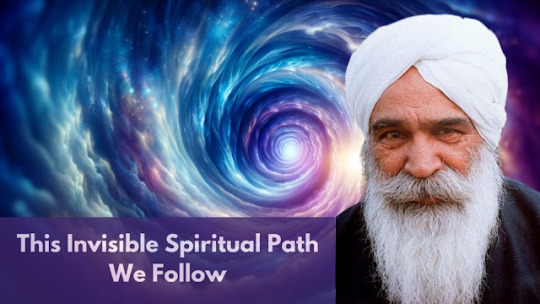
"The Father's kingdom is already spread out over the earth, and people do not see it." (Gospel of Thomas) This saying is a lament really, about souls in a condition of spiritual poverty unable to recognize the spiritual reality already here and available. This is the Invisible Spiritual Path We Follow, having a spiritual practice, a form of meditation that pertains to seeing the Unseen Realms with another kind of sight. The heavenly regions are not visible to those limited only to the outer material world of the five senses. In order to have mystic-vision, we're going to need another kind of Eye to be able to gaze into those subtle realms beyond. "The Lord will make the pupil of your eye his home, and your eye will expand to contain the entire universe." (Sant Namdev) "The eye through which I see God is the same eye through which God sees me; my eye and God's eye are one eye, one seeing, one knowing, one love." (Meister Eckhart, Rhineland Mystic) The third eye is the gateway which leads to realms above the purely physical world. It is situated behind and between the two eyes.
It is the birthright and evolutionary destiny of each and every soul to participate in the subtle divine worlds within, to become a child of both the outer creation, the cosmos, the universe we see all around us, AND to be a traveler of inner space, the kingdom of the heavens -- the Divine Ocean of Love -- accessed within through a very special kind of meditation of inner seeing and inner hearing. The Sufi mystic Ibn Arabi once wrote in his Bezels of Wisdom: "The Supreme Being brought the Cosmos into being as constituting an Unseen Realm AND a Sensory Realm, so that we might perceive the Inner through our Unseen [facilities] and the Outer through our sensory aspect." We are, in other words, meant to be children of both worlds.
"This new life of the Spirit begins from the day of Initiation into the Mysteries of the Spirit... The life of the spirit begins not with the theoretical exposition of the spiritual science but by a practical demonstration on the spiritual plane of the spirit-current made manifest. Here the invisible and inaudible life-stream is made both visible and audible to the Spirit within, converting the atheist into a theist in the true sense of the term. It is imparting the life-impulse and making It throb in every pore of the body. This coming back of the soul to the realization of her true nature and rising into Universal or Cosmic awareness beyond the walls of finitude is the true resurrection or coming to a new birth and a new life. To die in the body while living, is to live in the Spirit." (The Celestial Music, An Introduction to Kirpal Singh, by L. Gurney Parrott)
That last sentence, "To die in the body while living, is to live in the Spirit" is referring to the meditation practice that is followed by those initiated into Inner Light and Sound Meditation on this Path of the Masters.
"We should sit very lovingly in our meditation. We should focus at the Eye Center and do our Simran -- repeat the Simran in the mind. When we do this, the impurity of the mind, which has been cast on the mind by us for eons, for so many millions of lives... that gets washed off." (Baba Ram Singh)
This Invisible Spiritual Path We Follow - Spiritual Awakening Radio Podcast @ YouTube:
https://youtu.be/CqvLouGR0-Q
This Invisible Spiritual Path We Follow - Spiritual Awakening Radio Podcast - Listen and/or Direct MP3 Download @:
https://traffic.libsyn.com/spiritualawakeningradio/This_Invisible_Spiritual_Path_We_Follow.mp3
@ the Podcast Website With Buttons That Go To All the Popular Podcast APPS - Wherever You Follow Podcasts:
https://SpiritualAwakeningRadio.libsyn.com/this-invisible-spiritual-path-we-follow
@ Apple Podcasts:
https://podcasts.apple.com/us/podcast/this-invisible-spiritual-path-we-follow/id1477577384?i=1000635010587
@ Spotify:
https://open.spotify.com/episode/1s2yrQnGEI0gCTwls6YjOr
@ Audible:
https://www.amazon.com/Spiritual-Awakening-Radio/dp/B08K561DZJ
@ Google Podcasts:
https://podcasts.google.com/search/spiritual%20awakening%20radio
& @ Wherever You Subscribe and Follow Podcasts - At Your Favorite Podcast APP Just Do a Search for "Spiritual Awakening Radio" - (Apple Podcasts, Spotify, Google Podcasts, Amazon, Audible, PodBean, Podcast APP, Overcast, Jio Saavan, iHeart Radio, Podcast Addict, CastBox, etc...):
https://linktr.ee/SpiritualAwakeningRadio
In Divine Love (Bhakti), Light, and Sound, At the Feet of the Masters, Radhasoami,
James Bean
Spiritual Awakening Radio Podcasts
Sant Mat Satsang Podcasts
Sant Mat Radhasoami
A Satsang Without Walls
https://www.SpiritualAwakeningRadio.com
#spiritual path#podcast#satsang#spirituality#meditation#mystics#mysticism#christian mysticism#gospel of thomas#nag hammadi library#spiritual awakening#spiritual awakening radio#initiation#path of the masters#sant mat#radhasoami#sant mat satsang podcasts#go within
9 notes
·
View notes
Text
Self-Defense for Gentlemen and Ladies
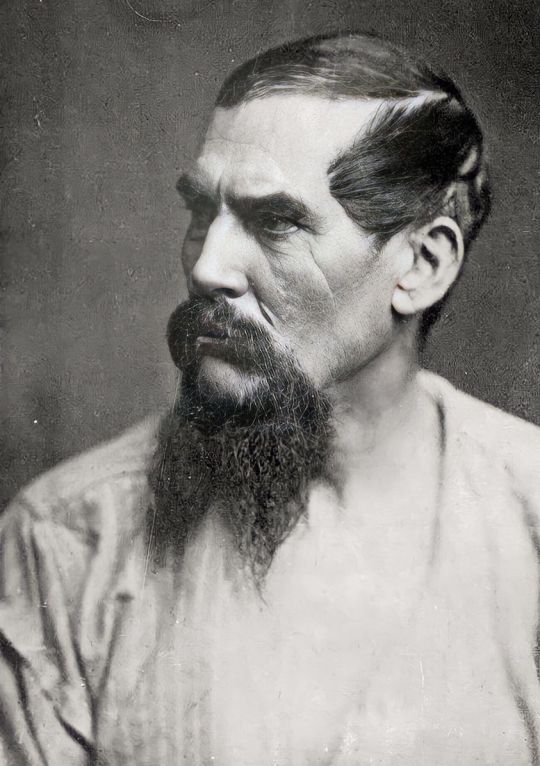
Sir Richard Francis Burton (1821-1890) was a notorious superhero (or antihero) and swordsman of the Victorian era. While at Trinity, the half-Irish Burton challenged another student to a duel for mocking his moustache. Burton learned 29 languages and became proficient in fencing. During an expedition to Africa, he was impaled with a native spear, the point entering one cheek and exiting the other, and leaving a scar that can be seen in this photo. He was forced to make his escape with the weapon still stuck through his face. Along with participating in clandestine operations, Burton was renowned for his fighting skills and earned the nickname "Ruffian Dick" because he had "fought in single combat more enemies than perhaps any other man of his time." Burton authored a number of important texts on the sword (including Sword & Bayonet Exercises, a classic book on the history of the Sword, and his "Sentiment of the Sword" about fencing) and translated a number of important Eastern cultural and mythological texts. A scholar, spy, and world explorer, he also had an interest in the occult, native sexual practices, drugs, runes, snake charming, was initiated into an esoteric Sufi brotherhood, as well as into a Hindu sect, all of which made him a subject of controversy and fascination in his time. A linguist, he reportedly learned to identify up to 60 monkey "words," which he recorded in a "monkey vocabulary." In 1886, Queen Victoria made him Knight Commander of St. Michael and St. George.
5 notes
·
View notes
Text
ISLAM 101: Spirituality in Islam: Part 201
Faqr and Ghina (Poverty and Richness)
For Sufis, poverty means that an initiate claims possession of nothing and is freed from all kinds of attachment toward worldly things, and that one feels total neediness and destitution before God in one’s relationship with Him, which is based on servanthood and God being the Sole Object of Worship. It is not poverty as understood by ordinary people, nor does it mean begging from people by displaying one’s privations.
The Sufi way of poverty involves severing relationships with all that is other than the Eternally Besought-of-All, and depending only on Him to meet one’s needs. For this reason, the more detached one is from whatever is worldly and temporary and the more annihilated one is in depending on Divine Attributes and Essence, the more one has attained poverty and can repeat the saying of the Prophet, upon him be peace and blessings: Poverty is my pride. [1]
As it is stated in a blessed saying, when poverty becomes a dimension of faith and submission, one no longer depends on the help, will, and power of that which is not God. Even if such a person has enough wealth to fill the whole world, since it is subject to decay and exhaustion, one does not depend upon it, but rather turns to God with all of one’s strength and feeling, conscious of his or her essential poverty and helplessness. How beautiful is the following couplet of Nabi, a seventeenth-century ce Ottoman poet:
Do not despise poverty, O Nabi!
Poverty is the mirror where the independence of others is reflected.
Rumi made another fine observation about poverty:
Poverty is the essence and all else is form;
Poverty is a remedy and all else the disease.
The whole world consists in vanity and conceit;
But poverty is the real core and meaning of existence.
Even if a person cannot discern his or her essential weakness and poverty with the light of belief, it is a reality that he or she is weak, poor, and needy. God Almighty declares: O mankind! You are poor in your relation with God, while God is He Who is the All-Wealthy and Worthy of Praise Who returns abundantly whatever is done for Him (35:15). As everybody absolutely needs His act of choice, will, and decree to come into existence, His Self-Subsistent and All-Subsisting Existence is also needed at every moment to survive.
An individual’s poverty and neediness before the Almighty is not a means of humiliation; rather, one’s increased awareness of one’s poverty engenders higher degrees of dignity, for such awareness before the Absolutely Wealthy One is richness itself. The believer becomes aware of his or her non-dependence on others, and acquires the consciousness of independence to the extent that one feels in his or her conscience that God is the sole source of power and wealth. His help is sought, and it is there-fore to Him that one turns. Even if such a person is materially poor, he or she feels no need for anything or somebody else.
The believer is convinced that whatever or whoever exists, including himself or herself, essentially belongs to the Almighty, for all elements of creation are only shadows of the shadow of His absolutely independent existence. This degree of conviction of God’s Unity is called annihilation in God, two steps ahead of which is subsistence with God. Concerning this, Hayali says:
Hayali, cover your naked body with the shawl of poverty;
This is their pride, they know not of satin or silk.
Poverty is the goal of saints, the (natural) state of purified scholars, and the most manifest sign of love of God. The Almighty has placed poverty in the hearts of His friends so that those hearts may prosper through it. Poverty is a key of light to open the eye of the heart to the inexhaustible treasuries of God. One who has this key is the richest person in the world, for poverty is the door to richness. Those who pass through this door reach (in their conscience) the infinite treasuries of the Owner of All Property and discover that poverty is identical with richness. For this reason we can say, as Junayd al-Baghdadi did: Richness is no more than the final, perfect degree of poverty. [2]
When one is perfectly conscious of one’s essential poverty before God and one’s absolute dependence on Him, one is absolutely rich, for such a person no longer feels any need. This is what must be meant by the famous saying: The real richness is the richness of the heart. When one has attained this degree of richness, it is as if he or she has found a credit card that is valid everywhere. One who has such mysterious capital can be considered neither poor nor powerless. This is what is described in the following lines:
His is power, by which we are powerful.
We are well-known by His Name or fame.
We go beyond peaks and continue our way;
We overcome all difficulties with ease.
We possess nothing worldly but are absolutely rich,
And are dignified and respectable by His Dignity.
We follow the way of contemplation, so
Whatever exists is a source of knowledge of God for us.
[1] Al-‘Ajluni, Kashf al-Khafa’, 2:87.
[2] Al-Qushayri, Al-Risala, 273.
#allah#god#islam#muslim#quran#revert#convert#convert islam#revert islam#revert help#revert help team#help#islamhelp#converthelp#how to convert to islam#convert to islam#welcome to islam
3 notes
·
View notes